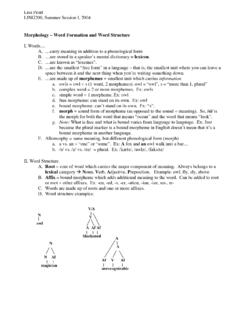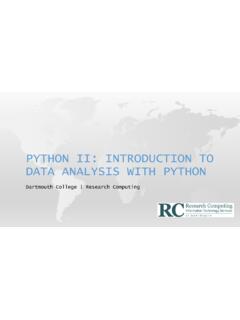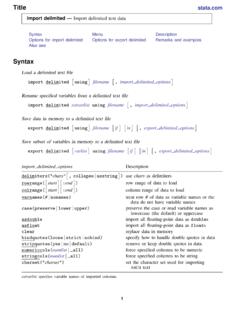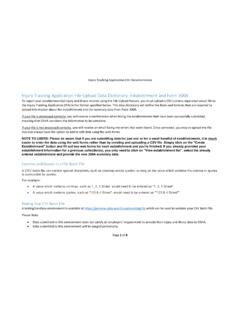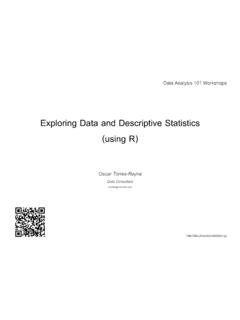Transcription of USER’S GUIDE TO - University of California, Irvine
1 USER S GUIDE TO Fuzzy-Set / Qualitative Comparative Analysis Charles C. Ragin Department of Sociology University of California, Irvine Irvine , CA Assisted by: Tyson Patros Sarah Ilene Strand Claude Rubinson July 2017 fsQCA and this manual are updated every few months. Both can be downloaded from Based on: fsQCA Copyright 1999-2003, Charles Ragin and Kriss Drass Copyright 2004-2017, Charles Ragin and Sean Davey CONTENTS Chapter 1. data Files A) Opening a data File .. 1 B) Opening data Files of Various Formats .. 1 Excel SPSS Stata Word / Notepad C) Saving File Options.
2 2 D) Opening fsQCA data in Other Formats .. 3 SPSS Stata Excel Chapter 2. data Editor A) Entering data .. 5 Variable Names Number of Cases B) Editing data .. 7 Add / Delete Variables .. 7 Compute 11 Recode Variables .. 11 1) Recode Variables Into Same Variables 2) Recode Variables Into Different Variables Calibrating Fuzzy 13 Add / Insert Cases .. 15 Delete Cases.
3 15 Select Cases If .. 16 C) Working with Output .. 17 Printing Documents Saving Results Chapter 3. Basic Procedures, Descriptive Statistics, and Graphs A) Necessary Conditions .. 18 Obtaining Necessary Conditions Sample Output B) Set Coincidence .. 20 Obtaining Set Coincidence Sample Output C) Subset/Superset Analysis .. 21 Obtaining Subset/Superset Analysis Sample Output D) Descriptives.
4 23 Obtaining Descriptive Statistics Sample Output E) XY Plot .. 24 Obtaining XY Plots Sample Output Chapter 4. Crisp-Set Analysis A) Basic Concepts .. 27 1) Use of Binary data 2) Boolean Negation 3) Use of Truth Tables to Represent data 4) Groupings 5) Boolean Addition 6) Boolean Multiplication 7) Combinatorial Logic Minimization .. 31 1) Use of Prime Implicants.
5 33 2) Use of De Morgan s Law .. 35 3) Necessary and Sufficient Causes .. 36 B) data .. 37 C) Analysis .. 37 Truth Table 38 Specify Analysis .. 41 Standard Analysis .. 42 Limited Diversity and Counterfactual Analysis .. 42 Chapter 5. Fuzzy-Set Analysis A) Operations on Fuzzy 46 Logical AND Logical OR Negation B) Fuzzy Sets, Necessity, and Sufficiency (Fuzzy Subset Relation).. 48 C) Using the Fuzzy Truth Table 50 D) data and 50 E) Specify Analysis Option.
6 55 F) Standard Analysis Option .. 56 G) Output for Specify Analysis Option .. 57 H) Output for Standard Analysis Option .. 59 G) Consistency and Coverage .. 60 Page 1 Chapter 1. data FILES A) Opening a data File FsQCA opens with the following window: From the menu choose: File Open In the Open File dialog box, select the file you want to open. Click Open. B) Opening data Files of Various Formats data files come in a wide variety of formats, and the software is designed to handle the following: comma - separated values (*.
7 Csv) or comma -delimited file, produced by Excel and other spreadsheet software Page 2 Space separated (*.txt) space delimited file, can be created in WORD or other word processing software and saved as text only Tab separated (*.dat) tab delimited file, can be created using SPSS and other statistical software packages Raw data files (*.raw) generated by Stata (extension can be changed to *.csv if saved in the comma -delimited format). The recommended formats are *.csv (Excel) and *.dat (SPSS). Please note that fsQCA makes the following assumptions about the structure of *.csv, *.dat and *.txt data files.
8 First, and most important, fsQCA assumes that the cells in the first row of the spreadsheet contain variable names for their respective columns. Second, fsQCA assumes that the data begin in the second row of the spreadsheet and that each case is a single row. Finally, fsQCA assumes that each column contains cells of the same type of data . data types can vary across columns, but they must be consistent within columns. Please remember to use very simple variables names, using only alphanumeric characters with no embedded punctuation or spaces. For example, GNP1990 is OK, but GNP 1990 and GNP-1990 are not.
9 Opening / Saving data originally created in Excel: Save the Excel file in *.csv ( comma separated Values) format. Make sure that the first row of the Excel data spreadsheet contains the variable names. Open in fsQCA. Opening / Saving data originally created in SPSS: Save the SPSS file in *.dat (tab delimited) format or *.csv ( comma separated Values) format. SPSS will ask you whether you want to Write variable names to file. Do not uncheck this option. Opening / Saving data originally created in Stata: Save the Stata file in *.dta format and then go to File, Export, and choose file as comma - separated data .
10 In the new window, insert the file name for Write to the file, then for Delimiter choose comma - separated format, and click Submit. In some versions of Stata you may need to rename the new *.dta file as a *.csv file. Opening / Saving data originally created in Word / Notepad: Enter the data delimited by spaces. Make sure that the first line contains the variable names, also separated by spaces. Save the file in a *.txt (Text only) format, TXT (Text with Line Breaks), TXT (MS-DOS), or TXT (MS-DOS with Line Breaks). Open in fsQCA. C) Saving File Options From the menu choose: File Page 3 The modified data file is saved, overwriting the previous version of the file of the same name and location.




